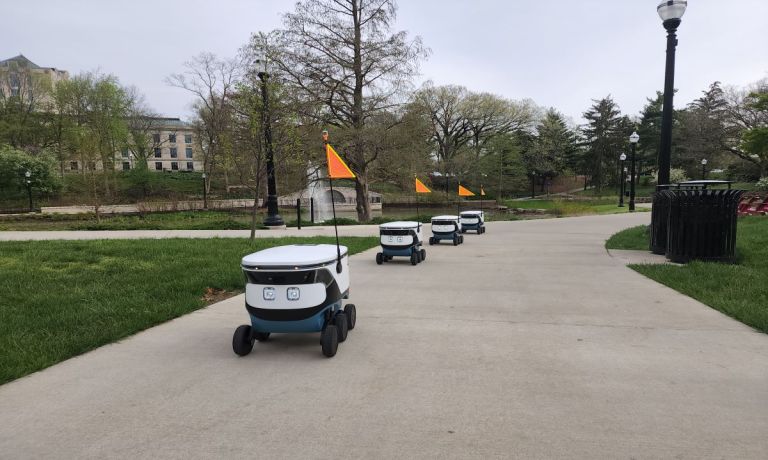As food delivery demand remains elevated, and restaurants and aggregators struggle with a difficult courier labor market, many are turning to robotics to automate the process and boost capacity. Grubhub, for one, announced on Monday (June 13) that it is partnering with Cartken, a self-driving robotics company, to offer autonomous deliveries on college campuses.
More here: Grubhub Gears Up for Full Rollout of Campus Delivery Robots
Anjali Naik, chief operating officer and co-founder of Cartken, explained in an interview with PYMNTS Wednesday (June 15) that the company sees robotics not as a full replacement for human delivery drivers and couriers, but rather as a complement.
“[We’re] augmenting the current runners that they have and the volumes that Grubhub sees on the campuses,” she said. That’s really where robots fit in nicely, to shuttle food around in these short distance at those volume. … We’ve always seen this as something that will expand traditional delivery options, having this add-on to the delivery network that we see today.”
Indeed, across the aggregator space, key players are tapping robotics to make the process more efficient. Uber Eats announced in mid-May the launch of two robotic delivery pilot tests, one in partnership with driverless vehicle technology company Motional and one with autonomous sidewalk delivery company Serve Robotics.
Related news: Uber Eats Launches Two Robotic Delivery Pilots as Restaurant Industry Struggles to Meet Demand
Advertisement: Scroll to Continue
DoorDash, meanwhile, discussed its autonomous delivery efforts in a company announcement issued in November, with Stanley Tang, the company’s co-founder and chief product officer and Harrison Shih, director and head of product at DoorDash Labs, noting that the company has partnered with Starship Technologies, Marble Robot, and Cruise Automation and that the aggregator plans to “facilitate automation across the most repetitive part of delivery.”
By the Numbers
Consumers increasingly expect to have food brought to their door, with more than four in 10 ordering from restaurant delivery aggregators at least once a month, according to data from the May edition of PYMNTS’ ConnectedEconomy™ Monthly Report.
For more: 19M More Consumers Went Online to Bank, Buy and Pay Bills in May 2022
The study, which drew from a survey of more than 2,600 U.S. consumers, found that the share of consumers using restaurant aggregators at least once a month rose from 40% in April to 43% in May. Moreover, the share of all consumers purchasing from restaurant aggregators daily rose from about 6% in April to about 7% in May.
Of the consumers who make purchases from restaurant aggregators, 41% of use Grubhub, as wa revealed by findings from the March/April edition of PYMNTS’ Digital Divide series, “The Digital Divide: Regional Variations in U.S. Food Ordering Trends and Digital Adoption, created in collaboration with Paytronix. The study, which drew from a February survey of more than 2,500 U.S. adults who regularly purchase food from restaurants, also found that 71% of aggregator users purchase from competitor DoorDash and 48% from Uber Eats.
See also: New Research Shows That Regional Dining Quirks Matter in Tailoring Restaurant Offers
The Context
It’s not just aggregators looking to robotic solutions to improve delivery models. Some restaurant brands are looking to cut out the middleman, running their own delivery businesses with the help of robotic labor solutions. For instance, Chipotle announced last March its participation in autonomous delivery company Nuro’s Series C funding round, and Domino’s announced the following month that it was testing out robotic pizza delivery in Houston this week using Nuro’s R2 robot.
You may also like: In Houston, Domino’s Road Tests Nuro’s R2 Robot For Pizza Delivery
Meanwhile, it was reported this past April that Chili’s parent company Brinker International is trialing sidewalk robot delivery, and less than a week earlier, the company had announced the expansion of its drone delivery partnership with Flytrex to Texas. Similarly, Manasquan, New Jersey-based sandwich chain Jersey Mike’s Subs announced its own drone delivery partnership with Flytrex about a month ago.
Read more: Chili’s Parent Trials Sidewalk Delivery Robots
Adoption of these technologies has accelerated.
“We’re seeing large companies, major players in quick-service retail, grocery chains, convenience stores, even shipping companies that are making decisions really fast,” said Naik. “Before, it just seemed like a very slow process.”
P2P Robotic Deliveries
Naik sees the current moment as something of a tipping point for robotic delivery. She contended that the space is transforming “from cute robots being just a showpiece and an innovation project” to them now beginning to be “part of a mainstream delivery network.”
As the technology becomes more mainstream, she predicts that soon it will not only be businesses leveraging robotic delivery technology but also consumers delivering items peer-to-peer (P2P). She explained that she “started really thinking about” this use case in response to the recent formula shortage, noting that robots could present a cost-effective and convenient solution.
“This kind of technology is something that could very easily, in a low-cost method, pick up formula from one household deliver it to another,” she said. “That’s something that could be a really interesting, cool part of the future.”




